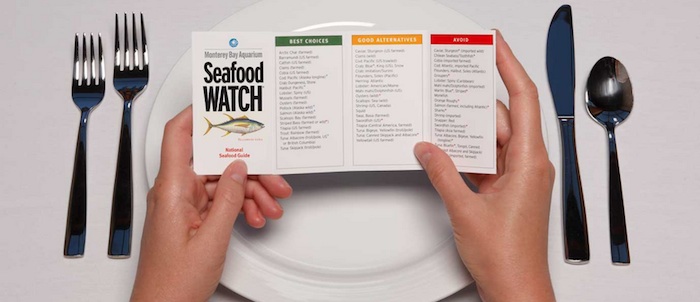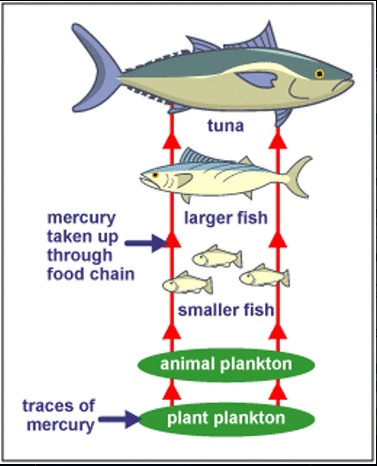
I’m 32, and for many women my age we’re thinking about having kids or are in the middle of raising a family. The unfortunate reality is that our fish today are polluted with various heavy metals from everyday consumer products, mining and manufacturing pollution.
Most women know to stay away from tuna during pregnancy, but what other fish should we be concerned about?
And should we start thinking about this before we get pregnant?
Heavy metals and bioaccumulation
 Heavy metals range from mercury, lead, arsenic, cadmium and chromium. These are metals that are found in children’s jewelry, everyday electronics, consumer products, some occur naturally in the environment, or are released when burning coal. These heavy metals whether they migrate out of consumer products, leach into landfills or are released into the air, end up in our water and food supply.
Heavy metals range from mercury, lead, arsenic, cadmium and chromium. These are metals that are found in children’s jewelry, everyday electronics, consumer products, some occur naturally in the environment, or are released when burning coal. These heavy metals whether they migrate out of consumer products, leach into landfills or are released into the air, end up in our water and food supply.
Bioaccumulation is the process of metals (and other chemicals) working their way up the food chain, and ultimately into our bodies. The basic idea is that lots of little fish have little amounts of say, mercury, in their bodies. Little fish are eaten by bigger fish in large amounts, resulting in higher mercury levels for the larger fish. Humans are on the top of the food chain and when we eat these large fish, we ingest large amounts of mercury in our bodies.
The problem is that heavy metals in our bodies can harm the developing brain of the fetus and often stay in our bodies … forever (hence the term they are persistent). For more information on “PBT” persistent, bioaccumulative and toxic chemicals, read Safer Chemicals fact sheet here.
Fish to avoid
Tuna is a large fish and is part of the reason doctors warn against eating too much tuna during childbearing years, but the problem doesn’t stop there. Many other fish contain contaminants that you want to avoid before getting pregnant. You’ll notice some popular menu items on the list below like, Mahi Mahi, farmed Atlantic salmon, and imported shrimp.
Seafood Watch at the Monterey Bay Aquarium spends endless hours doing the research to create “safe” and “avoid” lists. The great news is they incorporate environmental sustainability and fishing practices in their ratings, in addition to heavy metal and contaminants concerns.
Here is the “red list” of large fish to avoid according to Seafood Watch:
- Abalone (China & Japan)
- Cod: Pacific (Japan & Russia)
- Crab: Red King (Russia)
- Lobster: Spiny (Belize, Brazil, Honduras & Nicaragua)
- Mahi Mahi (imported)
- Orange Roughy
- Salmon: Atlantic (farmed)
- Sharks
- Shrimp (imported farmed)
- Shrimp (LA & Mexico wild)
- Squid (imported)
- Swordfish (imported)
- Tuna: Albacore/White canned (except Canada & US troll, pole and US longline)
- Tuna: Bluefin
- Tuna: Skipjack/Light canned (imported longline and purse seine)
- Tuna: Yellowfin (except troll, pole and US longline)
Why you should cut back on these fish before you get pregnant
Scientific research shows that development while in the womb is incredible important for the health of the person throughout their life. A beautiful symphony happens, each minute, day and week are critical to the development of some new organ, hormone-function and brain development. If this symphony is disrupted by heavy metals (or other toxic chemicals), the effects can impact a person for a lifetime.
The scientific literature is also telling us that a woman’s exposure to certain chemicals before she gets pregnant are as important as when she is pregnant. This is related to my first point that many chemicals are persistent and stay in our bodies.
Take for example toxic flame retardants. They are a class of chemicals that were and are widely used on couches, upholstery and children’s products made of foam. (It should be noted that these chemicals do little to nothing to slow the spread of fires.) The chemicals build up in the food chain, marine life, and in our bodies. They stay in our bodies for a lifetime. PCBs are another example: despite being banned before I was born, the likelihood of me having PCBs in my body is very high according to biomonitoring studies conducted by the CDC.
It’s hard for young women to think about having babies before their ready. I’m not asking women and girls to spend years worrying about chemicals, but if you’re like me and thinking about kids in a few years, I suggest cutting back on the high-on-the-food-chain fish I listed above.
What is safe to eat?
Good news, there is a lot of sustainably sourced and highly nutritious fish for you to eat! I use the Seafood Watch app all the time, whether I’m in the grocery store or at a restaurant (who can keep this all straight.. am I right?). Download the app to your phone here.
Safe, nutritious fish according to Seafood Watch:
- Abalone
- Bass: Striped (US hook & line, farmed)
- Catfish (US)
- Clams, Mussels, Oysters
- Cod: Pacific (US hook & line, longline & trap)
- Crab: Dungeness & Stone (US)
- Halibut (US Pacific)
- Lobster: Spiny (Mexico)
- Salmon (AK)
- Sardines: Pacific (Canada & US) [I wrote about these buggers and their health benefits here]
- Scallops (farmed)
- Shrimp: Pink (OR)
- Tilapia (Ecuador & US)
- Trout: Rainbow (US farmed)
- Tuna: Albacore/White canned (Canada & US troll, pole)
- Tuna: Skipjack/Light canned (FAD-free, US troll, pole)
- Tuna: Yellowfin (US troll, pole)
Never miss a post and join my email list.
(Photo credits: Seafood Watch, Great Pacific Garbage Patch, kiermacz – Flickr CC)




As a mother of a child with special needs, I definitely think we need to beware of what we consume while pregnant (and always, frankly). Whenever I try to think back to what went wrong with my son – he just came out different, I can never pinpoint anything but I remain convinced that his challenges reflect the increased toxins in our environment. I’m all done having children but am glad that you are sharing this so others who are considering having kids can get educated.
Love this article. It really distinguishes which fishes are okay and not based upon the actual fish type. Sharing.
Women have it pretty rough in this toxic world we live in — you have to think about what you put in your body before you ever even think about getting pregnant really. Especially since so many pregnancies are unplanned. I wish I had known all this green info before I got pregnant. I love Monterey Bay Aquarium and their mission so much! Their membership is a little pricey but I feel good knowing that our money is supporting ocean conservation.
Excellent attention to detail, as always,with information everyone can use! It’s good to have alternatives, and I certainly don’t want to feel like I can’t buy any fish for my family.